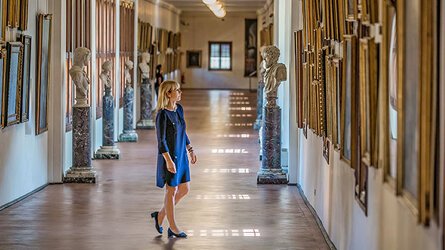Overview
Itinerary
Embark your ship and settle into your stateroom. Boston is a city of firsts brimming with historic charms and a vibrant culture. Its compact size, stately architecture and plentiful green spaces make for easy exploration. Historic buildings appear on every corner, from the Old South Meeting House where Samuel Adams started the Boston Tea Party to the Old North Church where two lit lanterns signaled the British approach. Boston's parks system also exudes a rich sense of history. The Boston Common, dating to 1634, is the country's oldest city park and the adjacent Public Garden was the first public botanical garden.
Boston harbors a lively and youthful energy despite its Puritan roots and Brahmin heritage. When Bostonians are not sipping coffee in an inviting outdoor café along the famed Newbury Street or walking the picturesque pathways of the Esplanade along the scenic Charles River, they are browsing the art and architecture that lend Boston its distinct character. The renowned Museum of Fine Arts boasts some 450,000 works, while the Isabella Stewart Gardner Museum showcases the stunning collection of its namesake socialite in a recreated 15th-century Venetian palazzo.
New York City is at once romantic and exhilarating. From the robust streets of Lower Manhattan's financial district to the intimate warrens of Greenwich Village, the city overflows with culture, cuisine and architectural beauty. New York is for everyone. Music lovers marvel at Carnegie Hall or catch a 1920s-style jazz and blues show in Harlem. Romantics board a horse-drawn carriage in Central Park. Art lovers browse the Museum of Modern Art or the Guggenheim. And theatergoers attend the greatest shows in the world on Broadway, amid the glitter of Times Square.
Of New York City's countless skyscrapers, none evoke as much romance and imagination as the ever-present Empire State Building. Originally drawn as a standard 50-story building, its plans were revised fifteen times. When completed in 1931, it surpassed the nearby Chrysler Building as the world's tallest skyscraper. Hundreds of splendid structures have since been raised around it, from 30 Rockefeller Plaza and the MetLife Building to One World Trade Center. But this art deco masterpiece was the first building in the world to exceed 100 floors.
Newport is a showcase of palatial mansions and stunning lawns and gardens on Narragansett Bay. Families such as the Vanderbilts and Astors constructed their grand houses here as extravagant retreats from the bustle of New York. Others followed, and soon the city was the second home of the most elite families in the nation. A sojourn along ten-mile Ocean Drive reveals much of the city's architectural and seaside splendor. The city's marina showcases a jaw-dropping collection of sleek, gleaming yachts.
Sail the Atlantic Ocean, divided in half, north to south, by the Mid-Atlantic Ridge. Longer than the Rockies, the Himalayas and the Andes combined, this underwater mountain range is the longest on Earth. As you sail, take advantage of the array of delicious cuisine offered on board. You may visit Mamsen's, our casual gourmet deli, any time from early morning to late at night for a taste of traditional Norwegian fare. Or, dine at Manfredi's and savor an authentic Italian meal, with options ranging from Milanese risotto to Tuscan inspired classics.
Halifax exudes a fine European air and lies along the edge of the Atlantic Ocean. Visitors by sea are greeted by the 1758 Sambro Island Lighthouse, the oldest surviving beacon in North America. In the harborside Historic Properties district, grand and charming stone buildings built in the 18th and 19th centuries grace the cobblestone streets. The city grew up around Citadel Hill, where Fort George protected the harbor. The fortress, along with the adjacent stately Halifax Town Clock, has been gloriously restored and preserved.
Sail legendary waters, where medieval Europeans believed “there be dragons” beyond the ocean's horizon. As you sail, explore our well-curated Library, tucked in a private alcove of the Living Room, and select from a broad range of titles. Read a book by the Main Pool, a calming oasis in any weather with its retractable roof, allowing for year-round swimming.
Gaspé is one of North America's earliest European settlements, set amid stunning natural beauty at the tip of the Quebec's Gaspé Peninsula on the Gulf of St. Lawrence. Claimed first by the French, then by the British, Gaspé is known as the “Cradle of French Canada.” Across a small bay from the charming town lies the rugged wilderness of Forillon National Park. With hundreds of species, the Gaspé Peninsula is a spectacular area for bird-watching, and the surrounding gulf is home to wildlife including blue and humpback whales.
Flowing through the fertile lowlands that link the US Great Lakes to the Atlantic Ocean, the St. Lawrence River is one of North America's most scenic waterways. Canada's second longest river features a number of great cultural capitals, including the stately facade of Château Frontenac, the gleaming skyline of Montreal and the pastoral island of Île d'Orléans. To the island's east, the river widens into the largest estuary in the world, passing small towns, gently rising hills and rocky banks. Farther east, the long Île d'Anticosti marks the mouth of the river.
Quebec City is by many accounts the most French city in New France. The Old Town's centerpiece, the magnificent Château Frontenac, seems transported from the palatial landscapes of the Loire Valley, and its French-accented streets lead past white-stone buildings that evoke old-world medieval villages. The only remaining walled city in North America outside of Mexico, Quebec City was fortified in the 17th century soon after its founding in 1608. Its strategic setting on the rocky promontory of Cape Diamond gave troops a close view of the St. Lawrence.
Montreal enjoys a picturesque island setting on the St. Lawrence River. Historic Vieux-Montréal, or Old Montreal, evokes the early days of fur trading. The heart of the city is rich with stone houses, inviting boutiques and grand public buildings. The 1829 neo-Gothic Notre-Dame Basilica on the Place d'Armes, is one of the city's most beloved structures; its colorful interior includes a deep blue ceiling sprinkled with gold stars and stained glass windows. In the Bonsecours Market, a classic Palladian-style, domed building, shops and cafés are a lively stage for daily life.
Vieux-Montréal, or Old Montreal, preserves the rich character of an old colony. Archaeological remains from the city's first settlement are preserved in the Pointe-à-Callière museum. The silver dome of the Bonsecours Market, a splendid Renaissance Revival building, sheltered Montreal's main market for over a century and briefly hosted the Parliament of United Canada in 1849. Adjacent, the Chapelle Notre-Dame-de-Bon-Secours is one of the city's oldest churches, and the historic Château Ramezay once hosted Benjamin Franklin as he sought to recruit troops against the British. After breakfast, disembark your ship and journey home.
Life Onboard Viking Mars

With her maiden voyage in 2022, the Viking Mars is an all-veranda ship, part of Viking's fleet of award winning ships incorporating all the comforts & luxuries you would expect from Viking. Read more

Viking are destination experts. With no casinos or children on board, you can be assured that the focus is firmly on enrichment and education. Read more

After a day of exploration or just to enhance the relaxation of a day at sea, the on-board Spa will leave you feeling recharged and revitalized. Read more

Viking offer eight on board dining options. Beer, wine and soft drinks are available with lunch and dinner at no additional charge of fee. Read more

Viking proudly includes all that you need and nothing you do not. A variety of features and services valued at $200 per person per day are standard inclusions in your cruise. Read more

Viking include one complimentary shore excursion in every port of call. Enjoy exclusive entry to cultural treasures and seldom-seen collections around the world. Read more

Viking Mars Reviews (7) View All Most Recent 'Viking Mars' Reviews
Brochure

Viking Expeditions (2023-25)
Availability Click on prices below to view cabin upgrades and details
Tour & cruises prices are per person. Prices shown have savings applied, are subject to availability and may be withdrawn at any time without notice. Pricing and trip details are correct at this point in time, however are subject to confirmation at the time of booking and are subject to change by Viking. For cruise itineraries, cabin images are sourced from Viking. These should be treated as indicative only. Cabin inclusions, upholsteries and room layout may differ to the image(s) shown depending on the ship selected and your sailing dates.









